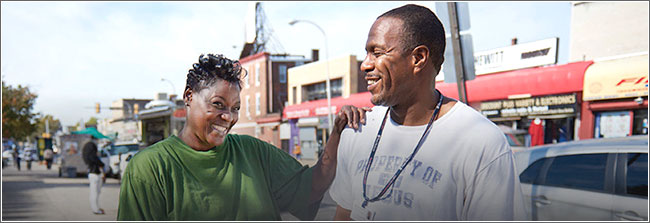Health Equity
News
Dismantling Health Disparities in Philadelphia and Beyond
Text and Video: Inside Penn's Community Health Workers Program

Community health workers can help patients in ways others can’t — but these programs haven’t always been successful. The Penn Center for Community Health Workers (PCCHW) reversed that trend and is a national model. This article is cross posted from Penn News.
One of the American health care system’s most stubborn challenges is the vicious circle of poor health and poverty which continues to snare high-risk patients.
Health care providers are only half-equipped to handle these cases, but there is one special category of laypeople — community health workers (CHWs) — which has proven highly effective in turning this vicious circle into a virtuous one of improved wellness and prosperity. These are people whose compassionate nature, life experience, and specialized training equip them to help high-risk patients in ways that others cannot.

Shreya Kangovi, MD, MSHP, is an Assistant Professor at Penn’s Perelman School of Medicine and a Senior Fellow at the Leonard Davis Institute of Health Economics (LDI).
As popular as CHW programs around the country have been, many have met with less than optimal outcomes. So when Shreya Kangovi, founding executive director of the Penn Center for Community Health Workers (PCCHW), set about designing one that would be more effective in improving the health of high-risk patients, she started by asking the experts.
Seeking patients’ help
The experts she turned to first weren’t her peers at the Perelman School of Medicine, where she is an assistant professor, nor her colleagues at Penn’s Leonard Davis Institute, where she serves as a Senior Fellow. Rather, she and her research team turned to the high-risk patients themselves to ask what they thought was causing their communities’ widespread health problems — and what should be done to improve it.
Their feedback revealed the underlying causes to be more social than medical: job, housing, or food insecurity; obtaining childcare, transportation, or time off work to get to the doctor; the prohibitively high cost of medications. And when asked what kind of support they needed to navigate these barriers, the patients cited health provider liaisons who could relate to their lives, who wouldn’t judge them, and who could provide emotional as well as functional support.
Kangovi used this patient feedback to design the Individualized Management for Patient-Centered Targets (IMPaCT) program, putting particular emphasis on CHW recruitment and training. https://www.youtube.com/embed/vimeo://v/207348087?feature=oembed
“We hire really talented people, people who were born to do this kind of work,” says Jill Feldstein, PCCHW’s chief operating officer. “And it’s important to us to provide career opportunities so they can grow professionally without having to stop doing work they love. That’s why we launched Career Paths, our center’s career development program for community health workers and their supervisors.”
Reversal in turnover rate
As a result of this approach, they’ve had virtually no turnover in a field known to have a high turnover rate. The emphasis on recruiting the right people, paired with providing them comprehensive training, structured supervision, and clearly defined work practices, including protocols to ensure CHW safety, positions IMPaCT’s 30 CHWs — and the more than 2,000 high-risk patients they care for each year — for success.
“There’s an emphasis in health care today on quality over quantity, and with that comes the need to provide care tailored to the unique needs of patients. The patients who are part of IMPaCT really benefit from working with a CHW, which complements the care provided by doctors and nurses,” says Ralph Muller, CEO of the University of Pennsylvania Health System. “Since the Penn Center for Community Health Workers started, we’ve seen that by deploying these skilled and caring problem-solvers into the community and embedding them on our units improves quality of life for these patients and has a direct impact on their health and well-being, while saving money on avoidable hospitalizations.”

The Individualized Management for Patient-Centered Targets program was shown to increase access to primary care by 12 percent and reduce likelihood of recurrent hospital readmissions by 25 percent.
Transformative work
Other proponents of the program include Ezekiel Emanuel, chair of the Department of Medical Ethics and Health Policy at Penn. In Emanuel’s most recent book, “Prescription for the Future: The Twelve Transforming Practices of Highly Effective Medical Organizations,” he names PCCHW as one of the titular organizations that has improved both quality of care and the patient experience while also lowering costs, and holds it up as a role model for nationwide efforts to transform health care.
The PCCHW is already serving as a national model.
“We recently launched the IMPaCT Communities Program to help organizations across the country design and implement successful CHW programs to serve their high-risk patient populations,” says Scott Tornek, PCCHW’s chief strategy officer.
Open-source toolkit
The program’s extensive offerings include an open-source toolkit “so other organizations don’t have to reinvent the wheel,” says Tornek, as well as workflow and reporting software specially designed for CHW programs.
This software, called HOMEBASE, has also enabled PCCHW to quantify their own impressive outcomes. An article they published in JAMA Internal Medicine in 2014 reported that a two-week “dose” of IMPaCT was shown to increase access to primary care by 12 percent, reduce likelihood of recurrent hospital readmissions by 25 percent, and measurably improve patients’ mental health and level of engagement with health care providers.
IMPaCT also demonstrated a 2:1 return on the Health System’s investment, illustrating the model’s clear benefit to a national landscape where the whole health system is groaning under a fiscal weight that is in turn pricing millions of high-risk patients out of quality health care.
“The policy environment is constantly changing,” says Feldstein, who came to PCCHW with an extensive background in public policy. “But regardless of what’s happening in the political environment right now, we will continue to rigorously track our outcomes to demonstrate the effectiveness of the program and keep making known how much social issues affect people’s health.”
~ ~ ~
Christina Cook is a Penn News staff writer.